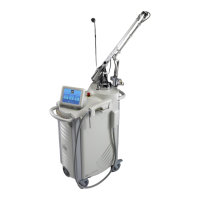Safe Start Protocol for BBL
Acne Treatment
Refer to Acne Treatment Parameters for appropriate fluence selection.
The goal when treating with the BBL for acne is the use of porphyrin as a
photosensitizer – not as a heat inducer. Due to the fact that BBL acne
treatment is not a thermal treatment, fluence is important to the extent
that it be at the appropriate level, in combination with the right pulse
width, to equal a sufficient dose of light needed to penetrate the skin and
stimulate the destruction of P. acnes bacteria. Fluence should not need to
be adjusted from protocol settings since heat is not a desired endpoint.
Pulse Width
Refer to Acne Treatment Parameters for appropriate pulse width selection.
The appropriate dose of light will ensure destruction of P.acnes bacteria.
Long pulse widths will allow the treatment to remain photochemical vs.
photothermal. Pulse Width should not need to be adjusted from protocol
settings since heat is not a desired endpoint.
Cooling
Refer to Acne Treatment Parameters for appropriate cooling selection.
The BBL contact cooling crystal ensures that the epidermis is adequately
protected as the 420 nm and/or 590 nm light passes through the skin.
Managing patient expectations
Patients should understand that to see optimal results with BBL acne
treatments a minimum of 1 - 2 treatments every week for a
minimum of 6 treatments are recommended.
Treatment Basics
1. Apply thin layer of colorless gel.
2. Select appropriate settings.
3. Complete area to be treated
BBL Acne Treatment Parameters
Apply 420 nm filter with 2 passes first and then the 560 nm filter with 3 passes
and/or the 590 nm filter with 6 passes, except on Skin Type V. Only the 590 nm filter
with 6 passes should be usedon Skin Type V.
* On sensitive patients and patients with more severe acne, the use of a small
snap on adapter focused on individual acne lesions may help to minimize
discomfort and allow for all passes to be completed.
Not recommended for Skin Type VI.
There are no definitive endpoints. The treatment
goal is to pack the skin with light. Patients may feel
a slight tingling sensation. If area treated begins to
get warm, pause treatment until area cools down.
Post Treatment
1. Observation – Possible slight erythema for several
hours after treatment.
2. Intervention – Cool compresses or ice packs,
though rarely needed, can provide some comfort
after treatment. If blistering occurs, aggressive
wound healing measures should be implemented.
3. Interval – Treatments are performed 1 - 2 times per
weeks. A minimum of 6 treatments are
recommended. Destruction of P.acnes continues
for a few weeks following the last BBL treatment
and the effects of the treatment will be maintained
until bacterial populations rebuild to their initial
concentration. Some patients may require a
maintenance treatment within 3 – 6 months of the
initial series of treatments.
4. If performing an acne treatment in conjunction
with other procedures such as MLP or ProFractional,
perform the acne treatment first.
5. Check with manufacturer for guidelines on using
injectables in conjunction with acne treatments.
The pathogenesis of acne is multifactorial and
can be associated with four contributors:
follicular plugging, excess sebum, inflammation,
and the presence of Propionibacterium acnes
(P. acnes). P. acnes are a naturally occurring
bacterium that is present on the skin, as well as
within pores and sebaceous glands, at all times.
When dead skin and sebum become trapped
and block the pores, P. acnes rapidly multiply,
causing follicle damage and inflammation.
Once inflammation develops, the degree of
acne evolves, forming papules, pustules,
nodules, and cysts.
BBL visible light takes advantage of the
photosensitivity of porphyrins. The porphyrins are
produced by the P. acnes. The blue light will cause
photo
excitation of
these P. acnes
porphyrins. This
will form singlet
oxygen within
the
microorganism
itself, leading to
the selective
destruction of
bacteria.
Shorter
wavelengths
(blue light – 420 nm) are capable of the greatest
absorption that specifically target bacteria;
whereas longer wavelengths (red light – 590 nm)
produce deeper penetration into the skin, targeting
inflammation. The following graph illustrates
excitation of porphyrin in Soret Band and Q Bands.
Considering that P. acnes is rarely present without
concomitant inflammation, the treatment
combination of blue and red light hasdemonstrated
considerable success in treating mild to severe
inflammatory acne.

